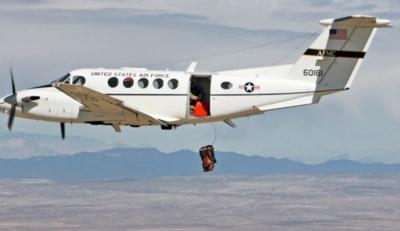Tue, Apr 15, 2014
Test Objective Was To Evaluate C-12C DUMP System For Static Line Dummy Drops
In an Air Force setting that is focused on being financially-conscious and proactive under the current financial challenges, the U.S. Air Force Test Pilot School, at the request of the 418th Flight Test Squadron here, is working with the squadron through the implementation of the school's Test Management Project, or TMP, to come up with a more cost-effective way of conducting dummy drop parachute testing for the Air Force.

Test Management Projects give students hands-on experience and oversight of a real-test program during the year long course.
"The C-12C (Huron) is much less expensive to operate compared to the C-130 (Hercules) and C-17 (Globemaster IIIs) that this type of testing is usually conducted with," said Capt. Phillip Hartnett, a flight test engineer and the project lead with test pilot school Class 13B. "The test aircraft was a C-12C modified with the Dummy Unloading Mechanical Platform (DUMP) to facilitate the dummy drops. This is the first time static line dummy drops have been conducted from a C-12C and this will provide the basis for conducting further static line testing using the C-12C. The end result will be significant cost savings for conducting this type of parachute testing."
According to Hartnett, the team's main objective for this test was to evaluate the C-12C DUMP system for static line dummy drops.
"(The configuration in the C-12C) allowed three dummies weighing between 185 and 350 pounds to be secured," Hartnett said. "Three 412th Operation Support Squadron test parachutists would slide a dummy onto a lift platform. When ready to deploy the dummy, the parachutists would lift the inboard side of the lift platform, which caused the dummy to slide out of the aft door. We cleared the C-12C static line dummy drop envelope from 1,500 feet (above ground level) to 10,000 (mean sea level) at airspeeds from 90 knots to 195 knots."
Prior to the drops, the team noted that they had to undergo pre-test coordination before flying.
"Since there was only a single flight test phase for this TMP, there were pre-test events like a test plan working group, a technical review board and a safety review board that had to be accomplished leading to the execution of the flight test," Hartnett said. "Even though the C-12C is already used to conduct live free-fall jumps, this will potentially be used in the future to conduct actual parachute testing. Dummies are used to mitigate risk to ensure the parachute deploys as expected prior to live jump testing."
During the planning and execution of this test, Hartnett mentioned there were a total of approximately 35 people who were contributing members and several different base organizations that were involved that included personnel from the 412th Test Wing, the TPS, the 412th Range Squadron, 412th OSS, 412th TW Test Safety, 733rd Test Squadron, 418th FLTS, 412th Test and Engineering Group, and L3 C-12C Maintenance.
"Since this was the first time this sort of testing has taken place, the safety process proved to be a challenge," Hartnett said. "Luckily, we had a very hard-working, cohesive team and our Logistics Lead Capt. Chris Nations and Safety Lead Capt. Joshua Duckett did excellent jobs ensuring the ground work was complete for a successful test. We received tremendous support from all parties and would like to thank everyone involved."
Dummy drop flight testing lasted from March 4 to 14. The student test team from Test Pilot School Class 13B was comprised of Maj. Jameel Janjua, Royal Canadian air force test pilot; Flight Lt. Marija Jovanovich, Royal Australian air force test pilot; Capt. Christopher Nations, Air Force test pilot; Capts. Joshua Duckett and Phillip Hartnett, both Air Force flight test engineers.
(Image provided by the U.S. Air Force)
More News
He Attempted To Restart The Engine Three Times. On The Third Restart Attempt, He Noticed That Flames Were Coming Out From The Right Wing Near The Fuel Cap Analysis: The pilot repor>[...]
Make Sure You NEVER Miss A New Story From Aero-News Network Do you ever feel like you never see posts from a certain person or page on Facebook or Instagram? Here’s how you c>[...]
From 2009 (YouTube Edition): Leading Air Show Performers Give Their Best Advice for Newcomers On December 6th through December 9th, the Paris Las Vegas Hotel hosted over 1,500 air >[...]
Aero Linx: NASA ASRS ASRS captures confidential reports, analyzes the resulting aviation safety data, and disseminates vital information to the aviation community. The ASRS is an i>[...]
“For our inaugural Pylon Racing Seminar in Roswell, we were thrilled to certify 60 pilots across our six closed-course pylon race classes. Not only did this year’s PRS >[...]
 NTSB Final Report: Rutan Long-EZ
NTSB Final Report: Rutan Long-EZ ANN FAQ: Turn On Post Notifications
ANN FAQ: Turn On Post Notifications Classic Aero-TV: ICAS Perspectives - Advice for New Air Show Performers
Classic Aero-TV: ICAS Perspectives - Advice for New Air Show Performers ANN's Daily Aero-Linx (06.28.25)
ANN's Daily Aero-Linx (06.28.25) Aero-News: Quote of the Day (06.28.25)
Aero-News: Quote of the Day (06.28.25)



